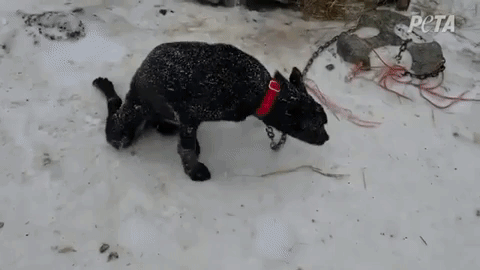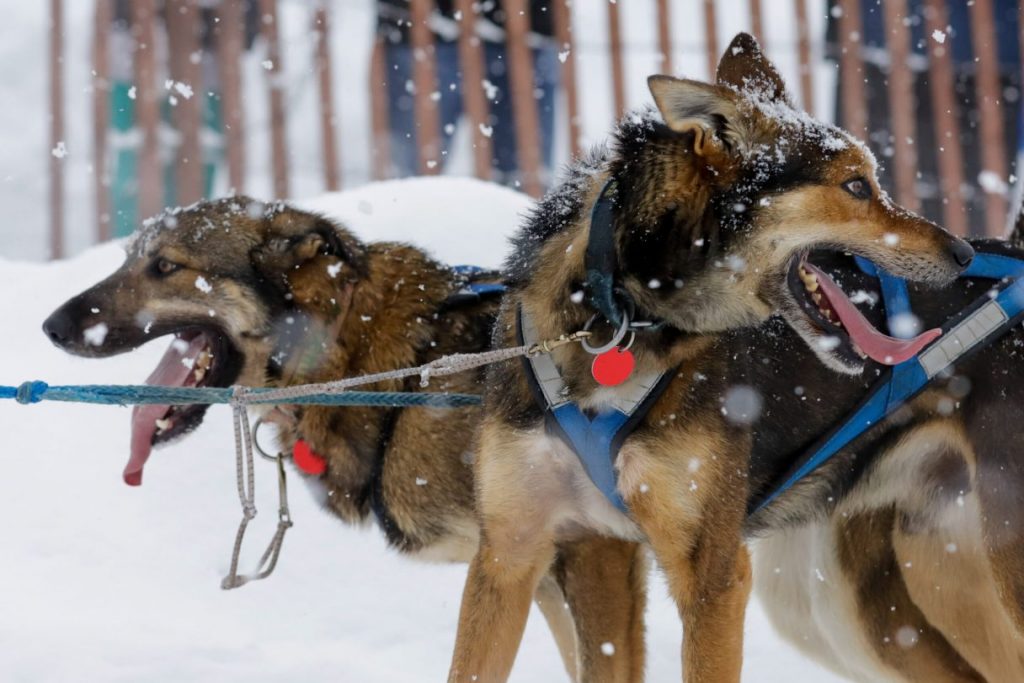Remember 5-year-old Oshi who died of aspiration pneumonia after her musher, Richie Beattie, forced her to race in the 2019 Iditarod? If human athletes were forced to compete until they died after inhaling their own vomit, there would be dire consequences—people would be jailed. And although Beattie—who was slated to take home the 2019 Iditarod Rookie of the Year Award—was disqualified after the dog’s death (per race rules), Ed Hopkins, the musher who did win the rookie award, announced that he’d be giving the $2,000 prize money to Beattie anyway. A win-win-lose situation, and—as is the norm in the cruel race—it’s the dog who pulled the fatal short straw.
What is aspiration pneumonia, and is it a common cause of death among dogs forced to race in the Iditarod?
There’s a reason why so many refer to the Iditarod as a “death race”—discover six of the most common illnesses and injuries that plague dogs along the event’s trail of suffering:
-
Aspiration Pneumonia
The leading cause of death for dogs made to race in the Iditarod is aspiration pneumonia—caused by inhaling their own vomit. A year before Oshi’s death, after the 2018 Iditarod, a necropsy report found that a dog named Blonde had died from aspiration pneumonia, too. And of those animals who survive the race, 81% are left with lung damage and 61% with gastric ulcers. Mushers are aware of these deaths and injuries—their continued pursuit of the Iditarod prize purse regardless of the known fatal risks shows their complete lack of concern about pushing dogs to and beyond their limits.
Oshi, one of the sled dogs who had just completed the Iditarod’s two-week icy trek of nearly 1,000 miles, died from pneumonia shortly after finishing the race. More than 140 dog deaths have been linked directly to the Iditarod since its launch in 1973. https://t.co/PJcvoj7MCL pic.twitter.com/jEv9AI4GXY
— Newsweek (@Newsweek) March 17, 2019
-
Asphyxiation
Dogs forced to run in the Iditarod death race have also died of asphyxiation (suffocation), but Dorado’s story is particularly horrifying: In 2013, after being dropped from the race because “he was moving stiffly,” the 5-year-old dog was reportedly buried in snow “in an area set up to care for dogs” and he asphyxiated. According to reports, his dead body was discovered as many as five hours after he was last checked on—a completely preventable death.
Iditarod dog died of asphyxiation, buried in snow http://t.co/xN9GGxv581
— CBS News (@CBSNews) March 17, 2013
-
Wet Lung
On March 15, 2017, two dogs collapsed and died on the Iditarod trail. The necropsy report indicated that one of them—3-year-old Shilling—died as a result of abnormalities that included “extensive pulmonary edema,” caused by excess fluid in the lungs (aka “wet lung,” a serious respiratory condition). The other victim, 4-year-old Flash, reportedly died of aspiration pneumonia, which, as we know, is also caused by foreign substances in the lungs. Shilling’s and Flash’s deaths—the fourth and fifth of 2017, respectively—made the race the deadliest Iditarod since 2009, when six dogs died.
Update: FIVE dogs now are dead because of this #Iditarod race. Shilling, a 3 y/o, has just died. It has got to end! https://t.co/PV76cEiYJx pic.twitter.com/CnkjH71zHu
— PETA (@peta) March 16, 2017
-
Hyperthermia
Also during 2017’s particularly deadly Iditarod, a 2-year-old dog named Smoke died of hyperthermia, or overheating. Smoke was being flown from Galena, Alaska, to Anchorage after being dropped from the race because of an apparent wrist injury when race officials said he “died unexpectedly.”
Update: Another dog has died during the #Iditarod race, a 2 y/o named Smoke. Dogs deserve better! https://t.co/PV76cEiYJx
— PETA (@peta) March 13, 2017
-
Hypothermia
During 2009’s especially fatal race, Dizzy and Grasshopper—two of the six victims of that year’s Iditarod—reportedly died of hypothermia after they were stuck outside in temperatures that plummeted to minus 45 degrees.
 © twitter.com/peta
© twitter.com/peta
-
Struck by Vehicles
The 2022 Iditarod death race was still more than a month away, but already a dog had been killed: On January 19, a team of dogs forced to race by Jaye Foucher—a musher registered for this year’s Willow 300 and Iditarod races—was hit by a truck, killing one of them (Noddy) and injuring others. The Willow 300 is a qualifying race for the Iditarod.
The speciesist dogsledding industry killed Noddy.
He never should have been forced to race for the profit and “entertainment” of humans.
Liberty Media and other sponsors MUST stop paying for dogs to die in races! https://t.co/fEGy3YBccl pic.twitter.com/rUJ3OMgTnP
— PETA (@peta) January 20, 2022
On March 14, 2017, Groovy—who was dropped from his musher’s team—was reportedly struck by a car and killed after escaping from the home of a handler in Anchorage. In 2016, 3-year-old Nash died after being hit by a snowmobile during the race—three other dogs being forced to race were injured in the same collision. And in 2015, a dog named Stuart got loose and was later hit by a car.
Snowmobile attack on Iditarod teams in Alaska kills 1 dog, injures 6 others https://t.co/Pb4XuoF7AM pic.twitter.com/MdYeb1xn6t
— TODAY (@TODAYshow) March 13, 2016
The Iditarod should run itself to death and leave dogs alone.
These causes of death are the ones we commonly see in the Iditarod—they don’t include dogs who have died while being forced to train for the race, those who died while chained up outside in the off-season, or those who were killed because they weren’t fast or fit enough for competition or didn’t meet certain aesthetic standards (e.g., if they had white paw pads). Dogs who finish the race but are no longer useful to the industry may be shot, drowned, or abandoned to starve.
And as a PETA eyewitness investigation into two dog kennels owned by former Iditarod champions showed, even dogs who don’t die on the Iditarod trail or aren’t otherwise killed are still forced to endure widespread suffering and neglect.

This is Birch. She endured horrific neglect at this “kennel” co-owned by former Iditarod champion John Baker. Despite sustaining a crippling, extremely painful spinal cord injury when she was just a puppy, she was denied veterinary care and chained in the freezing cold 24/7.
No prize is worth a dog’s life or suffering. For Birch, Oshi, Dorado, Smoke, and countless other victims of the Iditarod, PETA will continue to protest the event’s cruelty. We’ll be monitoring this year’s death race closely. Check back here and follow @peta on Twitter for updates.

